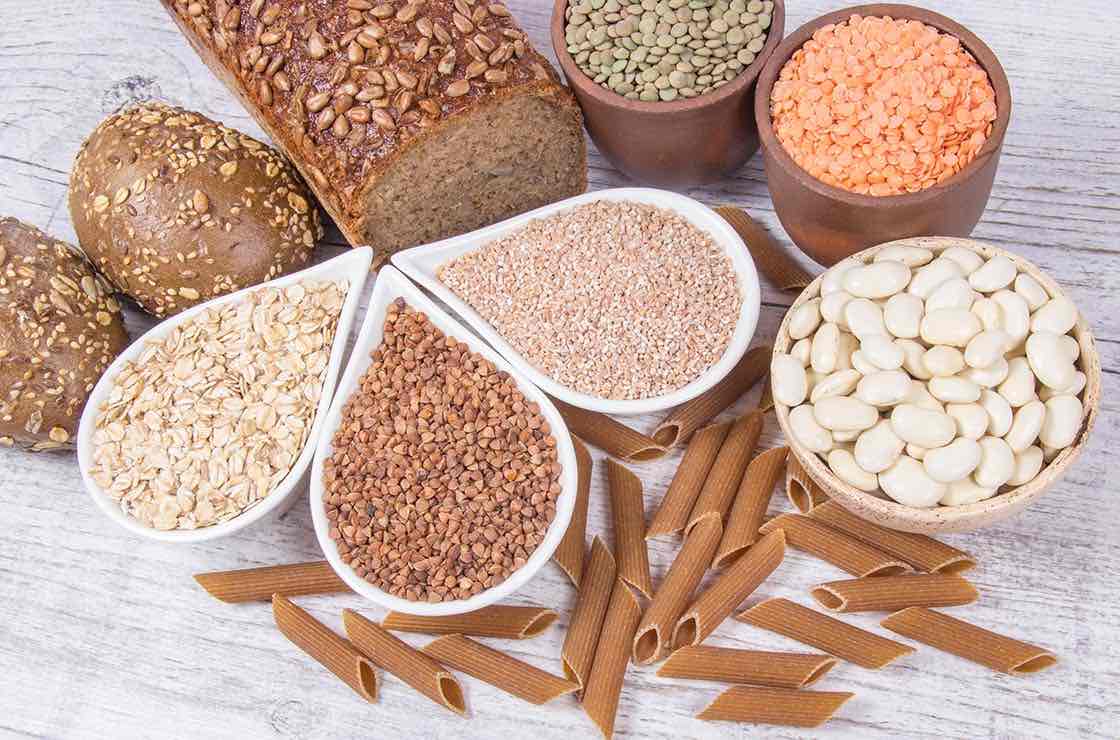Whether you’re an avid exerciser, a competitive athlete, or like to enjoy a nice walk a few times a week, here are carbohydrate recommendations for you.
I often hear people say, “Carbs make me gain weight,” or “Carbs make me feel gross,” and “Gluten doesn’t agree with me.” The list goes on. There is truth to these statements for many people, but the missing element is the type of carbohydrates they’re referring to. When people think of carbohydrates, they quickly think of bread, cookies, candy, sugar, baked goods, chips, and other packaged foods. But carbohydrates are in so many other foods – foods that are packed with nutrients and can also help maintain weight, fight off disease, and make you feel better each day.
Many people decide to remove carbohydrates (carbs or CHO) from their daily meals without understanding the purpose or benefit of them. Often times, they aren’t completely sure which foods are actually considered carbs. Daily total carbohydrate recommendations can vary greatly depending on your activity level, but there are several carb-rich foods you should be focusing on each day.
To understand which carbohydrates to be mindful of, there are several things to account for. The type of carb-rich food, in addition to your age, gender, and activity level all play a role. Let’s take a closer look.
What are Carbohydrates?
Carbohydrates are one of the three main macronutrients – alongside protein and fat. They are the main energy source for the human body, including the brain! Without them, we can’t function (unless you’ve tricked the body into ketosis – more on that in my Fad Diet article). There are five main types of food that contain carbohydrates: fruits, vegetables, grains, legumes, and dairy.
What are simple carbohydrates?
These are carbohydrates that are easy for the body to process. They’re typically found in foods like milk, fruit juice, sugar sweetened beverages, candy, and other foods. While many of these are healthy, they often get a bad rap. If you’re a competitive athlete, it’s nearly impossible to reach energy needs without the help of some simple carbs.
What are complex carbohydrates?
Complex carbohydrates are given the name due to the varying nutrients they contain. It takes the body longer to digest this “nutrient cocktail.” It should be a goal to include these types of carbohydrates at meals and snacks because they can help maintain healthy blood glucose levels, as well as keep us fuller for longer after a meal or snack. Complex carbs can also help prevent the typical crash you can feel after a “sugar high.”
What is the Function of Carbohydrates?
Carbohydrates are vital for our day to day function. All carbohydrates are ultimately broken down into glucose, which is the fuel for our cells. That glucose forms ATP to give our energy systems fuel. This is one of the main reasons why carbs are important! The main functions of carbohydrates include:
- fuel for the muscles
- maintain blood glucose (sugar) levels
- provide storage fuel
Carbohydrate Recommendations: How Many Carbs Do You Need Per Day?
The general guidelines for a balanced diet say to aim for 45-65% of your total daily calories from carbohydrates. However, this isn’t the most reliable way to determine the needs of athletes or very active individuals. Instead, the requirement is based on a person’s weight and level of activity. Depending on the level of activity you do, you will fall between 3-12 grams of carbohydrate per kilogram of bodyweight (quite a range!). A more skill-based sport would be an example of the lower range, while ultra-endurance athletes are between 10-12 grams CHO/kg body weight. To calculate your body weight in kilograms, divide your weight in pounds by 2.2.
| Exercise Level | Carbohydrate Targets | |
|---|---|---|
| Light | Low intensity or skill-based activities | 3-5 grams (g) CHO per kilogram (kg) of body weight per day |
| Moderate | Moderate exercise program (eg, ~1 hour per day) | 5-7 g CHO/kg/d |
| High | Endurance program (eg, 1-3 hours/day of moderate to high intensity exercise) | 6-10 g CHO/kg/d |
| Very High | Extreme commitment (eg, >4-5 hours per day of moderate to high intensity exercise) | 8-12 g CHO/kg/d |
Table Adapted from: Thomas DT, Erdman KA, Burke LM. Nutrition and Athletic Performance. Med Sci Sport Exerc. 2016;48(3):543-568. doi:10.1249/MSS.0000000000000852
Here’s an example for a female who needs 5 grams (g) of carbs per kilogram (kg) of bodyweight per day.
Body weight (in pounds): 145 lb.
Body weight (in kilograms): 145 lb. / 2.2 = 65.9 kilograms
Carbohydrate recommendations per day: 65.9 kg body weight * 5 g CHO = 329.5 g CHO
Total Carbs to Eat Per Day: 330 g
Stay tuned for another post soon going into more depth about how to reach these carbohydrate needs! If you’re an athlete looking for specific recommendations, find a Registered Dietitian who specializes in sports nutrition.
Fibrous Carbohydrates
Fibrous carbohydrates include those that are high in fiber. There are two types of fiber – soluble and insoluble. Both have many health benefits, including regulating bowel movements, potentially helping to reduce certain types of cancer, preventing heart disease, helping the insulin response, promoting satiety, and aiding with weight maintenance. One of the main reasons why whole fruit is almost always a better choice than fruit juice is that it has naturally occurring fiber (yes this even includes pure juice made with juicers).
Fermentable Carbohydrates
Fermentable carbohydrates are sugars within carbohydrate foods that produce gas when they’re digested in the gut. Some people may experience symptoms when eating certain foods that are high in one or several of these types of carbohydrates, which are commonly known as FODMAPS (fermentable oligosaccharides, disaccharides, monosaccharides, and polyols).
The Low FODMAP Diet
The Low FODMAP Diet is used to help people identify which carbohydrate containing food is causing unwanted gastrointestinal (GI) symptoms. It is recommended to work with a dietitian to follow a proper protocol for this diet. For more resources visit the FODMAP Dietitian Directory with dietitians who have properly been trained to treat these symptoms.
Carbohydrate Food List Chart
This carbohydrate chart lists some common foods that are part of a healthy diet. As you can see here, not all carbohydrates are bad. Being “low carb” or “carb-free” eliminates a lot of great foods!
| Fruits | Vegetables | Grains | Legumes | Dairy |
|---|---|---|---|---|
| Berries: raspberries blueberries strawberries blackberries goji berries | Leafy greens: spinach kale arugula swiss chard collards | Rice: brown rice brown Jasmine rice wild rice forbidden rice | Lentils: red orange yellow green | Low-fat or nonfat Greek yogurt |
| Citrus: lemons oranges tangerines limes grapefruit | Cruciferous vegetables: broccoli cauliflower Brussels sprouts kale cabbage | Oats: steel cut old-fashioned | Beans: black pinto white kidney soybeans | Low-fat or nonfat milk |
| Drupes: apricots peaches plums nectarines cherries dates mango | Bulbs: garlic onion shallot | Wheat: farro triticale rye barley bulgur spelt | Green Peas | Unsweetened Kefir |
| Melons: cantaloupe honey dew watermelon | Root vegetables: radish parsnip carrots beets | Others: amaranth buckwheat quinoa teff | Chickpeas | Low-fat cheese |
| Tropical fruits: banana pineapple mango kiwi papaya pomegranate | Starchy vegetables: sweet potatoes turnips corn pumpkin squash cassava | Black-eyed peas | Butter (everything in moderation!) |
Fun Fact! Quinoa is often referred to as a grain, but it is actually a pseudo-cereal! It is one of the “grains” with the most amount of protein, and is a complete protein (has all of the essential amino acids).
Too Few Carbs Symptoms
Carbohydrates are seen as the devil, but take a look at the chart above one more time. These foods are packed with powerful plant compounds with incredible health benefits, can help control appetite, and can fuel our daily activities – including exercise. For anyone considering taking out carbs from their diet, it’s worth evaluating the true benefits of doing so. If you don’t eat enough carbs, you may feel fatigued, have trouble focusing, get stomach pains, and more.
There are many healthy ways to lose weight, and cutting out one of the three macronutrients isn’t sustainable nor enjoyable. Carbs can surprisingly be one of the best weight loss tools, as long as you’re choosing colorful fruits, vegetables, grains, and legumes that are packed with fiber, antioxidants, and other nutrients!
What are your concerns with carbohydrates? I’d love to hear in the comments below.




0 Comments